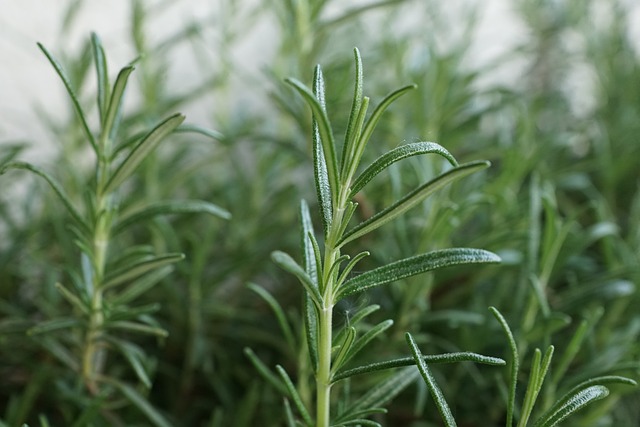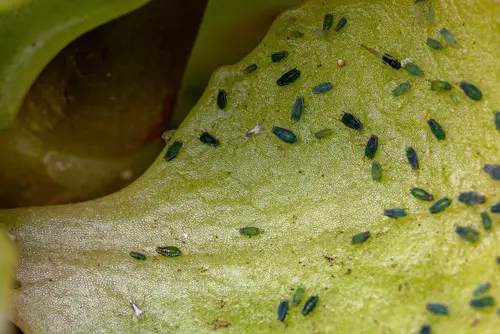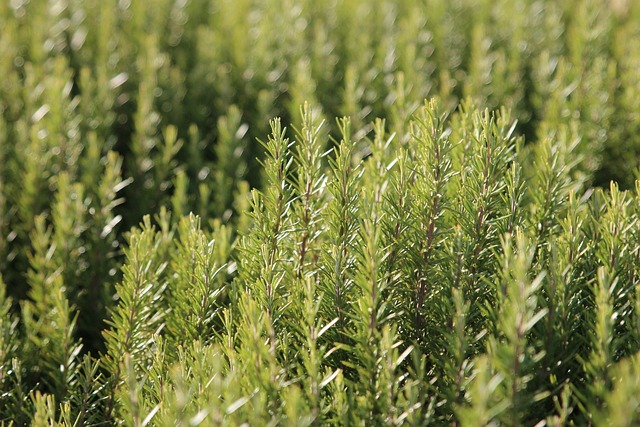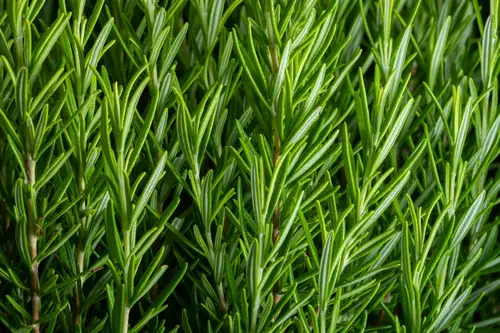White spots on rosemary leaves can be a common problem for gardeners. These spots can indicate a variety of issues, including fungal infections, insect infestations, and environmental stressors.
While white spots on rosemary leaves may not necessarily be harmful to the plant, it is important to identify the underlying cause and take appropriate steps to prevent or treat the issue.
Identifying the specific cause of white spots on rosemary leaves can be challenging, as there are many potential culprits. Some common causes of white spots on rosemary leaves include powdery mildew, spider mites, and whiteflies.
Additionally, environmental factors such as humidity, temperature, and soil conditions can also contribute to the development of white spots on rosemary leaves.
Preventing white spots on rosemary leaves requires a combination of proper plant care and pest management techniques. This may include regular pruning, proper watering and fertilization, and the use of natural or chemical insecticides when necessary.
Treating white spots on rosemary leaves will depend on the specific cause of the issue, and may involve removing affected leaves, applying fungicides or insecticides, or adjusting environmental conditions.
Key Takeaways
- White spots on rosemary leaves can be caused by a variety of issues, including fungal infections, insect infestations, and environmental stressors.
- Preventing white spots on rosemary leaves requires proper plant care and pest management techniques.
- Treating white spots on rosemary leaves depends on the specific cause of the issue, and may involve removing affected leaves, applying fungicides or insecticides, or adjusting environmental conditions.
More on this category:
Identifying White Spots on Rosemary Leaves

White spots on rosemary leaves can be an indication of a disease or a pest infestation. It is important to identify the cause of the white spots to properly treat the issue and prevent it from spreading.
One way to identify white spots on rosemary leaves is by using a magnifying glass. This can help to see the spots more clearly and determine their shape and size. Additionally, examining the underside of the leaves can reveal small insects or webs, which can indicate a pest infestation.
Another way to diagnose the cause of white spots on rosemary leaves is by observing the plant’s overall health. If the plant is weak or stunted, it may be a sign of a disease or nutrient deficiency.
It is important to note that not all white spots on rosemary leaves are harmful. Some spots may be a natural part of the leaf development process or caused by environmental factors such as sunburn.
White Spots on Rosemary Leaves – 4 Common Problems
Rosemary is a popular herb that is used in various dishes and for its medicinal properties. However, white spots on rosemary leaves can indicate a problem with the plant that needs to be addressed. Here are some common causes of white spots on rosemary leaves:
1. Powdery Mildew
Powdery mildew is a fungal disease that affects many plants, including rosemary. It appears as a white or gray powdery coating on the leaves, stems, and flowers of the plant. The disease is caused by a fungus that thrives in warm, humid conditions.
Powdery mildew can weaken the plant and reduce its ability to produce healthy leaves. To prevent powdery mildew, ensure proper air circulation, avoid overhead watering, and remove infected leaves.
2. Pest Infestation

Pests such as spider mites, aphids, mealybugs, and leafhoppers can cause white spots on rosemary leaves. These pests feed on the plant sap, causing damage to the leaves and leaving behind white spots. To prevent pest infestation, inspect the plant regularly, use insecticidal soap, and remove infected leaves.
3. Mineral Build-Up
Mineral deposits from hard water can cause white spots on rosemary leaves. When water evaporates, minerals are left behind and can accumulate on the leaves, causing white spots. To prevent mineral build-up, use filtered water or let tap water sit for 24 hours before using it on the plant.
4. Sunburn
Rosemary can get sunburned if it is exposed to too much direct sunlight. Sunburned leaves can turn white and become brittle. To prevent sunburn, provide shade for the plant during the hottest part of the day or move it to a location with less direct sunlight.
Preventing White Spots on Rosemary Leaves
Rosemary plants are prone to developing white spots on their leaves, which can be caused by various factors such as fungal attacks, pest infestations, and sunburn. However, with proper care and maintenance, it is possible to prevent the occurrence of white spots on rosemary leaves.
1. Proper Care
One of the most important things to keep in mind when caring for rosemary plants is to avoid overwatering. Rosemary prefers well-draining soil and does not tolerate soggy soil. It is recommended to water rosemary only when the top inch of soil is dry to the touch.
In addition, rosemary plants require good air circulation to prevent the growth of fungi that can cause white spots on the leaves. It is also important to place the plant in a sunny location where it can receive at least six hours of direct sunlight every day.
2. Maintaining Good Air Circulation
To maintain good air circulation around the rosemary plant, it is recommended to prune the plant regularly to remove any dead or diseased branches. This will not only improve air circulation but also promote new growth.
Placing a small fan near the plant can also help improve air circulation. However, care should be taken not to place the fan too close to the plant, as this can cause the leaves to dry out.
3. Preventing Overwatering

To prevent overwatering, it is important to use a well-draining soil mix and a pot with drainage holes. When watering, it is recommended to water the plant deeply and then allow the soil to dry out before watering again.
In addition, it is important to avoid getting water on the leaves when watering, as this can promote the growth of fungi that can cause white spots.
4. Avoiding Sunburn
Rosemary plants can also develop white spots on their leaves due to sunburn. To prevent sunburn, it is recommended to place the plant in a location where it can receive morning sun and afternoon shade.
In addition, it is important to acclimate the plant gradually to direct sunlight if it has been grown in a shaded location. This can be done by exposing the plant to direct sunlight for a few hours each day and gradually increasing the exposure over a period of several days.
By following these guidelines, it is possible to prevent the occurrence of white spots on rosemary leaves and keep the plant healthy and thriving.
Treating White Spots on Rosemary Leaves
If you’re seeing white spots on your rosemary leaves, it’s likely that your plant is suffering from a fungal infection or pest infestation. Fortunately, there are several effective treatments available that can help you get rid of these unsightly spots and restore your plant to health.
1. Using Fungicides
One of the most effective ways to treat white spots on rosemary leaves is to use a fungicide. Fungicides work by killing the fungi that are causing the spots on your plant’s leaves. There are several types of fungicides available, including organic and chemical options.
Before applying any fungicide, be sure to read the label carefully and follow the instructions closely. You may need to apply the fungicide several times to fully eliminate the fungus from your plant.
2. Applying Neem Oil
Another effective treatment for white spots on rosemary leaves is neem oil. Neem oil is a natural pesticide that is derived from the seeds of the neem tree. It works by disrupting the life cycle of pests and preventing them from reproducing.
To use neem oil, mix it with water according to the instructions on the label and apply it to your plant’s leaves. Be sure to cover the entire plant, including the undersides of the leaves, as this is where pests often hide.
3. Utilizing Baking Soda Solution
Baking soda is another natural remedy that can help you get rid of white spots on your rosemary leaves. Baking soda works by changing the pH of the plant’s leaves, making it more difficult for fungi and pests to survive.
To use baking soda, mix it with water to create a solution and spray it onto your plant’s leaves. Be sure to cover the entire plant, including the undersides of the leaves.
4. Pest Control Measures

If your rosemary plant is suffering from a pest infestation, there are several pest control measures you can take to get rid of the pests. Insecticidal soap, rubbing alcohol, and pesticide sprays are all effective options.
Before using any pest control measures, be sure to identify the type of pest that is affecting your plant. Different pests require different treatments, so it’s important to use the right product for the job.
Understanding the Impact of White Spots on Rosemary
White spots on rosemary leaves can be a sign of disease or a normal part of leaf development. However, if left untreated, these spots can have a negative impact on the plant’s yield and health. In this section, we will explore the impact of white spots on rosemary.
1. Impact on Rosemary Plant
White spots on rosemary leaves indicate the presence of a fungal disease called powdery mildew. This disease can weaken the plant, making it more susceptible to other diseases and pests. The spots can also interfere with photosynthesis, which can reduce the plant’s yield and overall health.
2. Impact on Yield
If left untreated, powdery mildew can significantly reduce the plant’s yield. The disease can cause the leaves to yellow, die, and fall off, which can reduce the plant’s ability to produce essential oils and other compounds that give rosemary its unique flavor and aroma.
3. Impact on Plant Diseases
White spots on rosemary leaves can also attract other diseases and pests. The weakened plant becomes more vulnerable to attacks from insects and other pests, which can further damage the plant and reduce its yield.
4. Impact on Toxicity
Rosemary is a popular herb used in cooking, but it can also be toxic if consumed in large quantities. While white spots on rosemary leaves do not directly impact the plant’s toxicity, a weakened plant may produce lower-quality compounds that can be harmful if consumed in large quantities.
Conclusion
White spots on rosemary leaves can be caused by various factors, but the most common culprit is powdery mildew. This fungal disease can cause the leaves to look dusty and white, and ultimately lead to stunted growth, yellowing, and falling off.
To prevent and treat powdery mildew on rosemary plants, it is important to maintain good plant hygiene, avoid overhead watering, and provide adequate air circulation. Pruning infected leaves and using organic fungicides can also help control the spread of the disease.
It is also important to note that white spots on rosemary leaves can sometimes be a natural part of leaf development or caused by other factors such as spider mites or mealybugs. Therefore, it is important to properly diagnose the cause of the white spots before taking any action.
Frequently Asked Questions

Can white spots on rosemary leaves be harmful to humans if consumed?
While white spots on rosemary leaves are not toxic to humans, they can indicate the presence of powdery mildew, a fungal disease that can affect the plant’s growth and overall health. It is not recommended to consume rosemary leaves that have been affected by powdery mildew.
How can powdery mildew on rosemary be treated?
Powdery mildew on rosemary can be treated with a variety of fungicides, including neem oil, copper soap, and potassium bicarbonate. Additionally, removing affected leaves and improving air circulation around the plant can help prevent the spread of the disease.
What is the best way to remove white fungus from rosemary?
The best way to remove white fungus from rosemary is to gently wipe affected leaves with a damp cloth or sponge. If the fungus has spread to the entire plant, it may be necessary to prune affected branches or even remove the entire plant.
Why does my rosemary have white spots and how can I prevent it?
White spots on rosemary leaves are typically caused by powdery mildew, which thrives in warm, humid conditions. To prevent powdery mildew, it is important to ensure that the plant has adequate air circulation, is not overcrowded, and is not overwatered.
Additionally, applying a preventative fungicide can help keep the disease at bay.
Are yellow spots on rosemary leaves a sign of disease?
Yellow spots on rosemary leaves can be a sign of a variety of diseases, including powdery mildew, root rot, and spider mites. It is important to identify the underlying cause of the yellow spots in order to properly treat the plant.
What is the white milky substance on my rosemary plant and how can I get rid of it?
The white milky substance on a rosemary plant is likely mealybugs, a common pest that feeds on the plant’s sap. To get rid of mealybugs, it is important to remove affected leaves and branches, and to apply a pesticide or insecticidal soap to the plant.
Additionally, introducing natural predators such as ladybugs can help control the infestation.

Hey, I’m Lisa and I’ve been an avid gardener for over 30 years. I love writing, talking and living in the garden! Feel free to connect with me on my socials below


